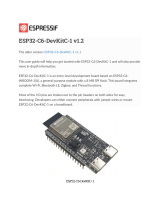
2 Pin Definitions
Table 2: Pin Definitions
Name No. Type aFunction
GND 1 P GND
3V3 2 P Power supply
EN 3 I
High: on, enables the chip.
Low: off, the chip powers off.
Note: Do not leave the EN pin floating.
IO4 4 I/O/T RTC_GPIO4, GPIO4, TOUCH4, ADC1_CH3
IO5 5 I/O/T RTC_GPIO5, GPIO5, TOUCH5, ADC1_CH4
IO6 6 I/O/T RTC_GPIO6, GPIO6, TOUCH6, ADC1_CH5
IO7 7 I/O/T RTC_GPIO7, GPIO7, TOUCH7, ADC1_CH6
IO15 8 I/O/T RTC_GPIO15, GPIO15, U0RTS, ADC2_CH4, XTAL_32K_P
IO16 9 I/O/T RTC_GPIO16, GPIO16, U0CTS, ADC2_CH5, XTAL_32K_N
IO17 10 I/O/T RTC_GPIO17, GPIO17, U1TXD, ADC2_CH6
IO18 11 I/O/T RTC_GPIO18, GPIO18, U1RXD, ADC2_CH7, CLK_OUT3
IO8 12 I/O/T RTC_GPIO8, GPIO8, TOUCH8, ADC1_CH7, SUBSPICS1
IO19 13 I/O/T RTC_GPIO19, GPIO19, U1RTS, ADC2_CH8, CLK_OUT2, USB_D-
IO20 14 I/O/T RTC_GPIO20, GPIO20, U1CTS, ADC2_CH9, CLK_OUT1, USB_D+
IO3 15 I/O/T RTC_GPIO3, GPIO3, TOUCH3, ADC1_CH2
IO46 16 I/O/T GPIO46
IO9 17 I/O/T RTC_GPIO9, GPIO9, TOUCH9, ADC1_CH8, FSPIHD, SUBSPIHD
IO10 18 I/O/T RTC_GPIO10, GPIO10, TOUCH10, ADC1_CH9, FSPICS0, FSPIIO4,
SUBSPICS0
IO11 19 I/O/T RTC_GPIO11, GPIO11, TOUCH11, ADC2_CH0, FSPID, FSPIIO5,
SUBSPID
IO12 20 I/O/T RTC_GPIO12, GPIO12, TOUCH12, ADC2_CH1, FSPICLK, FSPIIO6,
SUBSPICLK
IO13 21 I/O/T RTC_GPIO13, GPIO13, TOUCH13, ADC2_CH2, FSPIQ, FSPIIO7,
SUBSPIQ
IO14 22 I/O/T RTC_GPIO14, GPIO14, TOUCH14, ADC2_CH3, FSPIWP, FSPIDQS,
SUBSPIWP
IO21 23 I/O/T RTC_GPIO21, GPIO21
IO47 24 I/O/T SPICLK_P_DIFF,GPIO47, SUBSPICLK_P_DIFF
IO48 25 I/O/T SPICLK_N_DIFF,GPIO48, SUBSPICLK_N_DIFF
IO45 26 I/O/T GPIO45
IO0 27 I/O/T RTC_GPIO0, GPIO0
IO35 b28 I/O/T SPIIO6, GPIO35, FSPID, SUBSPID
IO36 b29 I/O/T SPIIO7, GPIO36, FSPICLK, SUBSPICLK
IO37 b30 I/O/T SPIDQS, GPIO37, FSPIQ, SUBSPIQ
IO38 31 I/O/T GPIO38, FSPIWP, SUBSPIWP
IO39 32 I/O/T MTCK, GPIO39, CLK_OUT3, SUBSPICS1
IO40 33 I/O/T MTDO, GPIO40, CLK_OUT2
IO41 34 I/O/T MTDI, GPIO41, CLK_OUT1
Cont’d on next page
Espressif Systems 8
Submit Documentation Feedback
ESP32-S3-WROOM-1 & WROOM-1U Datasheet v0.6

























